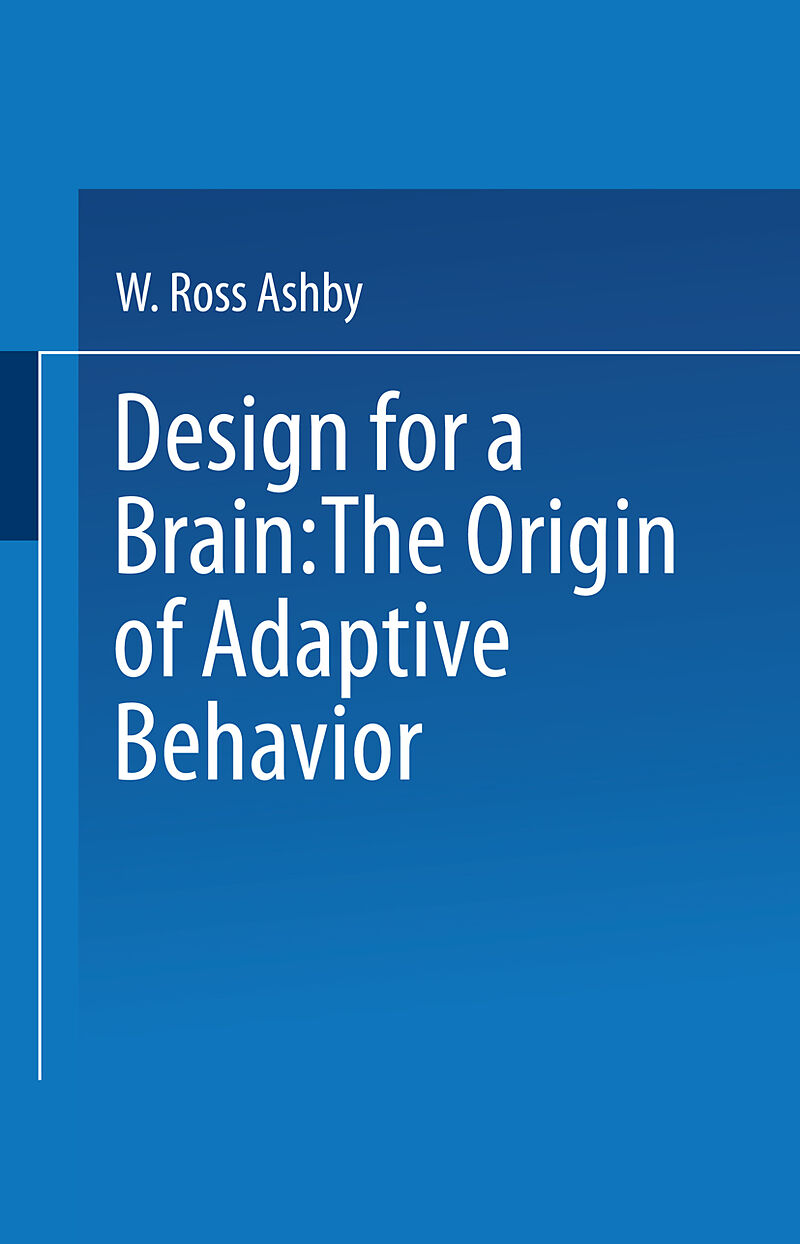Design for a Brain
Einband:
Kartonierter Einband
EAN:
9780412200908
Untertitel:
The origin of adaptive behaviour
Autor:
W. Ashby
Herausgeber:
Springer Netherlands
Auflage:
2nd ed. 1960
Anzahl Seiten:
300
Erscheinungsdatum:
01.03.1966
ISBN:
0412200902
THE book is not a treatise on aIl cerebral mechanisms but a pro poscd solution of a specific problem: the origin of the nervous system's unique ability to produce adaptive behaviour. The work has as basis the fact that the nervous system behaves adap tively and the hypothesis that it is essentiaIly mechanistic; it proceeds on the assumption that these two data are not irrecon cilable. It attempts to deduce from the observed facts what sort of a mechanism it must be that behaves so differently from any machinc made so far. Other proposed solutions have usuaIly left open the question whether so me different theory might not fit the facts equaIly weIl: I have attempted to deduce what is necessary, what properties the nervous system must have if it is to behave at once mechanisticaIly and adaptively. For the deduction to be rigorous, an adequately developed logic of mechanism is essential. Until recently, discussions of mechan ism were carried on almost entirely in terms of so me particular embodiment-the mechanical, the electronic, the neuronie, and so on. Those days are past. There now exists a weIl-developed logic of pure mechanism, rigorous as geometry, and likely to play the same fundamental part, in our understanding of the complex systems of biology, that geometry does in astronomy. Only by the dcvelopment of this basic logic has thc work in this book been made possible.
Klappentext
THE book is not a treatise on aIl cerebral mechanisms but a pro poscd solution of a specific problem: the origin of the nervous system's unique ability to produce adaptive behaviour. The work has as basis the fact that the nervous system behaves adap tively and the hypothesis that it is essentiaIly mechanistic; it proceeds on the assumption that these two data are not irrecon cilable. It attempts to deduce from the observed facts what sort of a mechanism it must be that behaves so differently from any machinc made so far. Other proposed solutions have usuaIly left open the question whether so me different theory might not fit the facts equaIly weIl: I have attempted to deduce what is necessary, what properties the nervous system must have if it is to behave at once mechanisticaIly and adaptively. For the deduction to be rigorous, an adequately developed logic of mechanism is essential. Until recently, discussions of mechan ism were carried on almost entirely in terms of so me particular embodiment-the mechanical, the electronic, the neuronie, and so on. Those days are past. There now exists a weIl-developed logic of pure mechanism, rigorous as geometry, and likely to play the same fundamental part, in our understanding of the complex systems of biology, that geometry does in astronomy. Only by the dcvelopment of this basic logic has thc work in this book been made possible.
Inhalt
1 The Problem.- 2 Dynamic Systems.- 3 The Organism as Machine.- 4 Stability.- 5 Adaptation as Stability.- 6 Parameters.- 7 The Ultrastable System.- 8 The Homeostat.- 9 Ultrastability in the Organism.- 10 The Recurrent Situation.- 11 The Fully-joined System.- 12 Temporary Independence.- 13 The System with Local Stabilities.- 14 Repetitive Stimuli and Habituation.- 15 Adaptation in Iterated and Serial Systems.- 16 Adaptation in the Multistable System.- 17 Ancillary Regulations.- 18 Amplifying Adaptation.- 19 The State-determined System.- 20 Stability.- 21 Parameters.- 22 The Effects of Constancy.- References.

Leider konnten wir für diesen Artikel keine Preise ermitteln ...
billigbuch.ch sucht jetzt für Sie die besten Angebote ...
Die aktuellen Verkaufspreise von 6 Onlineshops werden in Realtime abgefragt.
Sie können das gewünschte Produkt anschliessend direkt beim Anbieter Ihrer Wahl bestellen.
Loading...
Die aktuellen Verkaufspreise von 6 Onlineshops werden in Realtime abgefragt.
Sie können das gewünschte Produkt anschliessend direkt beim Anbieter Ihrer Wahl bestellen.
| # | Onlineshop | Preis CHF | Versand CHF | Total CHF | ||
|---|---|---|---|---|---|---|
| 1 | Seller | 0.00 | 0.00 | 0.00 |
